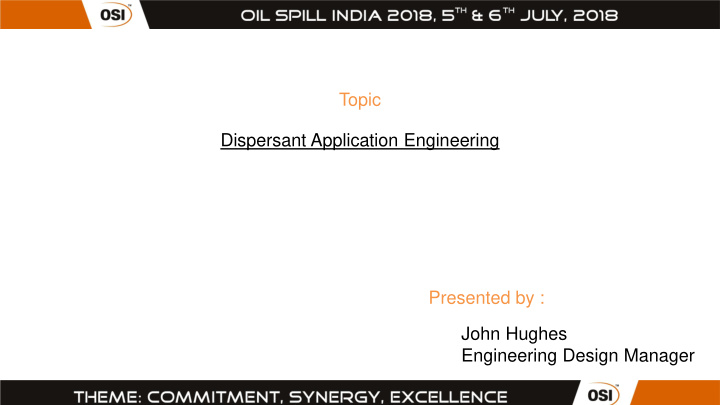



Topic Dispersant Application Engineering Presented by : John Hughes Engineering Design Manager
Dispersant Application Engineering Dispersant Basis of Design Solutions
The Role of Dispersant Enhance Remove Oil from Disperse oil into biodegradation the surface of the water column in of oil the water low concentrations
Isn’t Dispersant A Pollutant? Yes it can be! > When its not dispersing oil > What about when it is dispersing oil? • Environmental Policy makers will make these decisions based on Net Environmental Benefit Analysis
When we use Dispersant on Oil Spills is it a Pollutant? Dispersant doesn’t make contact with the oil > Misses the Target > Wrongly Identified target > Wrong Droplet Size and/or Velocity Oil is not amenable to dispersant > Weathered Oils > Stable Water in Oil Emulsion More dispersant is applied than is necessary > Incorrect Dispersant to Oil Ratio (DOR) > Incorrect operation of spray equipment
The Basis of Dispersant Application Engineering Targeting Droplet Size & Velocity Window of Opportunity Dosing
What Platforms Can We Use? Dedicated Adapted Vessels of Helicopters Fixed Wing Vessels Vessels Opportunity Aircraft
Targeting Slung Helicopter Fixed Wing Aerial Single Point Spray Systems Spray Nozzles Spray Systems Spray Arms AFEDO ™ NIMBUS STRATUS Fragmented Vessel/Aircraft Operator Considerations Weather Spills Handling Training
Droplet Size & Velocity AFEDO™ Spray Arms, Fixed Wing, Helicopter > Slightly less accurate, trade off with flexibility and speed > Nozzles with known droplet size characteristics > Low pressure nozzles maintain low droplet velocity Pump Flow to Pump Flow rate Considerations suit nozzles must be measured
Window of Opportunity Between a few hours and a few days If we don’t arrive and start spraying in time dispersant will NOT be effective Vessels on Standby Vessels of opotunity Aerial Spraying
Dosing The “ISO 9001” Oil Spill, 100m x 0.1mm Thick Equates to 1000L DOR = 1:10 Dispersant Vol = 100L DOR = 1:20 Dispersant Vol = 50L
Application Rate 100L per Hectare Flow Rate Vessel Speed Swath Width BOATSPRAY 200-8AL Dilute Dilute Neat Application Neat Application Dilute Dilute Dilute Dilute Dilute Area Vessel Vessel Neat Spraying Application Spraying 8AL Swath Rate (Yellow Rate (Black Application Application Rate Application Application Application Treatment speed in speed in Discharge Rate Discharge Width (m) Nozzle) Nozzle) Rate (10LPM) (20LPM) Rate (30LPM) Rate (40LPM) Rate (50LPM) Rate knots m/min Rate (LPM) (60LPM) Rate (LPM) (Lts/Hect.) (Lts/Hect.) (Lts/Hect) (Lts/Hect) (Lts/Hect) (Lts/Hect) (Lts/Hect) (km2/hr) (Lts/Hect) 2 62 120 160 20 968 1290 81 161 242 323 403 484 0.07 4 124 120 160 20 484 645 40 81 121 161 202 242 0.15 6 186 120 160 20 323 430 27 54 81 108 134 161 0.22 8 248 120 160 20 242 323 20 40 60 81 101 121 0.30 10 310 120 160 20 194 258 16 32 48 65 81 97 0.37 12 372 120 160 20 161 215 13 27 40 54 67 81 0.45 14 434 120 160 20 138 184 12 23 35 46 58 69 0.52
Which Equipment Should We Use? Each Type has its strengths… > When Possible use most Accurate • Small swath • Droplet Size > When Necessary use Fastest • Fast Transit to Spill • Large Swath • Large Dispersant Capacity
Questions?
Recommend
More recommend